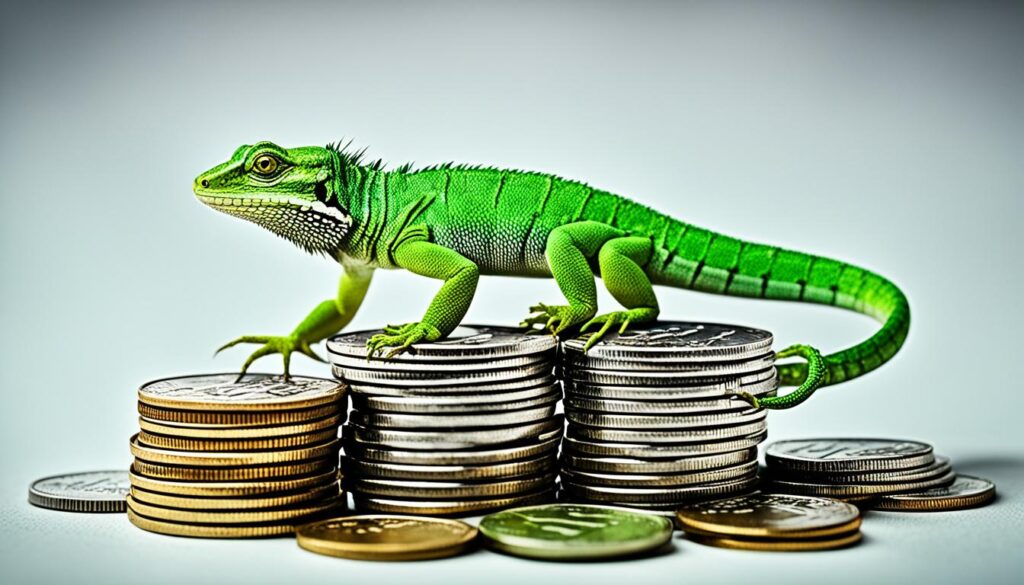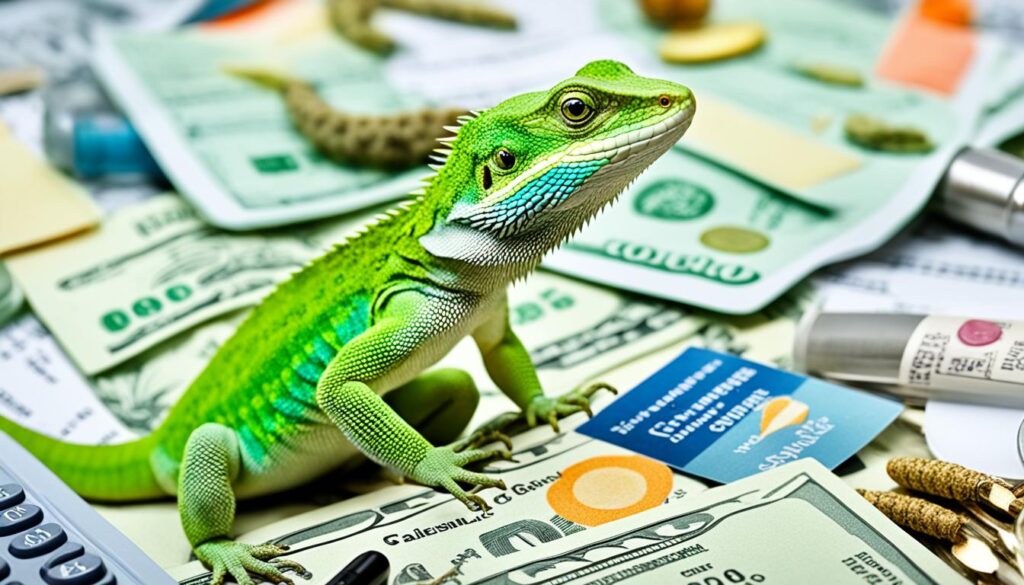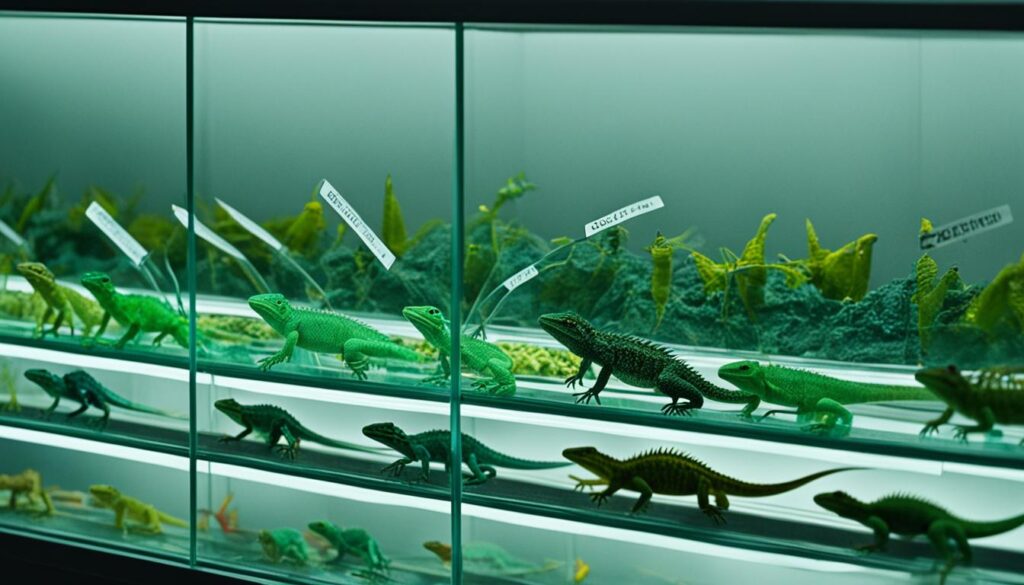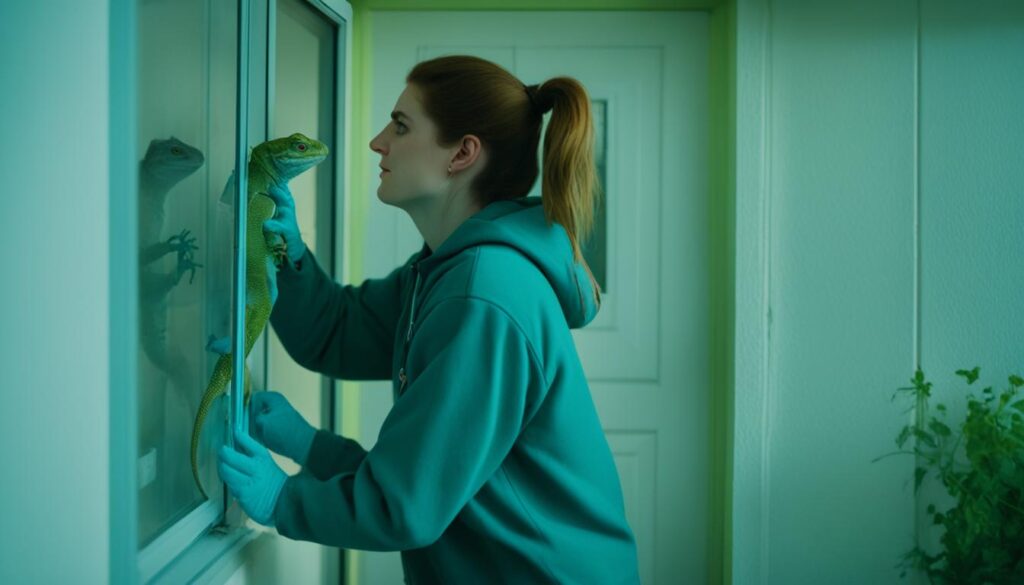Imagine walking into a reptile store and being greeted by rows of glass enclosures, each housing a captivating creature. Your eyes wander, searching for that perfect companion to join your family. And then you spot it, a beautiful lizard basking under the warmth of a heat lamp, its scales shimmering in the light. Your heart skips a beat, and you can’t help but wonder, “How much does a lizard like this cost?”
As you stand there, captivated by the enchanting world of lizards, you realize that owning one comes with its own set of considerations. From the initial purchase price to the ongoing expenses of care and maintenance, the cost of owning a lizard can vary significantly.
In this article, we will delve into the fascinating realm of lizard prices and uncover the factors that influence how much a lizard actually costs. Whether you’re a curious reptile enthusiast or someone considering adding a scaly friend to your family, this guide will provide valuable insights into the world of lizard ownership.
Key Takeaways:
- The cost of owning a lizard extends beyond the initial purchase price.
- Factors such as species, rarity, age, size, and coloration contribute to a lizard’s cost.
- Lizard care and maintenance expenses can significantly impact the overall cost of ownership.
- There are affordable lizard options available for those on a budget.
- Expensive and rare lizard species offer a unique but pricier pet ownership experience.
Factors Affecting Lizard Prices
When it comes to purchasing a lizard, the price can vary significantly based on several factors. By understanding these factors, you can make an informed decision and find the lizard that best fits your budget and preferences.
The following are the key factors that influence lizard prices:
- Species: The type of lizard you choose plays a significant role in determining its cost. Some lizard species, such as Bearded Dragons or Leopard Geckos, are more commonly found and, therefore, tend to be less expensive. On the other hand, species that are rare or have unique characteristics can come with a higher price tag.
- Age: The age of a lizard can also impact its price. Younger lizards may be priced lower because they require more time and effort to care for. Conversely, older lizards that are already mature and well-established may come with a higher price due to their readiness for breeding or exhibition purposes.
- Rarity: The rarity of a lizard species can significantly influence its cost. Lizards that are difficult to find in the pet trade or have specific genetic traits tend to be more expensive. Their scarcity and uniqueness contribute to their higher price point.
- Size: The size of a lizard can affect its price. Generally, larger lizards will be more expensive as they require more space, food, and care. Additionally, larger lizards may have been selectively bred to achieve their size, which can increase their cost due to the extra effort put into their breeding and raising.
- Coloration: Lizards with unique or rare color patterns may come with a higher price tag. These color morphs are often bred selectively to achieve specific color variations, making them more desirable among enthusiasts.
By considering these factors, you can better understand why certain lizards are priced higher than others and determine which factors are most important to you when making your lizard purchase.
Now that you have an overview of the factors influencing lizard prices, you can begin your search for the perfect pet lizard with a confident understanding of what to expect.
Popular Lizard Species and Their Price Range
When it comes to choosing a pet lizard, there are several popular species to consider. Each species has its own unique characteristics and price range. Knowing the average cost of these popular lizard species can help you make an informed decision based on your budget.
Bearded Dragons
Bearded Dragons are one of the most popular lizard species kept as pets. These friendly and docile reptiles come in a variety of colors and patterns. On average, the price range for Bearded Dragons is between $50 and $150. Factors such as color morphs and age may influence the cost.
Leopard Geckos
Leopard Geckos are another popular choice for reptile enthusiasts. Known for their striking appearance and low-maintenance care, Leopard Geckos are often priced between $30 and $100. Factors such as genetics, age, and morphs can affect the final price.
Crested Geckos
Crested Geckos have gained popularity in recent years due to their unique appearance and ease of care. These arboreal lizards are typically priced between $50 and $150, depending on factors such as color variations, patterns, and lineage.
Other Popular Lizard Species
In addition to Bearded Dragons, Leopard Geckos, and Crested Geckos, there are several other lizard species commonly kept as pets, each with its own price range:
- Blue-tongued Skinks: $150 – $400
- Ball Pythons: $50 – $200
- Green Anoles: $5 – $20
- Fire Skinks: $50 – $100
- Red-footed Tortoises: $200 – $500
Remember that prices can vary depending on factors such as age, size, coloration, and the reputation of the breeder or pet store. It’s always a good idea to do thorough research and consider the specific needs of each species before making a decision.
In the next section, we will explore the ongoing care and maintenance costs associated with owning a pet lizard. Understanding these additional expenses will help you budget and ensure the well-being of your scaly companion.
Lizard Care and Maintenance Costs
Owning a lizard comes with a commitment to their care and well-being. While the initial purchase cost of a lizard is important to consider, it is equally crucial to understand the ongoing expenses that come with owning one. In this section, we will explore the various factors that contribute to the overall cost of owning a lizard and provide insights into the pet expenses you can expect.
Factors Influencing Lizard Pet Expenses
Several factors influence the cost of owning a lizard. By understanding these factors, you can budget for the necessary expenses and ensure your lizard’s health and happiness.
- Enclosure Setup: Creating an appropriate habitat for your lizard is essential. This includes investing in a suitable enclosure, substrate, decorations, and heating and lighting equipment.
- Food: Lizards have specific dietary requirements, and their food costs should be factored into your budget. Depending on the species, this may include live insects, fresh fruits and vegetables, or specialized reptile diets.
- Veterinary Care: Regular check-ups and preventive care are crucial for your lizard’s well-being. Budget for routine vet visits, vaccinations, and potential medical expenses to ensure their health is maintained.
- Supplies: Various supplies such as thermometers, hygrometers, water dishes, and cleaning products are necessary for keeping your lizard’s enclosure clean, safe, and comfortable.
It’s important to note that the exact costs may vary depending on the specific needs of your lizard and their species.
“Proper care and maintenance are essential for the health and happiness of your lizard. By being prepared for the associated costs, you can ensure a fulfilling and rewarding experience as a lizard owner.”
To provide you with a real-life example of the expenses involved, here is a breakdown of the average monthly costs for owning a bearded dragon:
| Expense | Cost |
|---|---|
| Food | $30-$40 |
| Electricity (Heating and Lighting) | $20-$30 |
| Substrate and Bedding | $10-$15 |
| Veterinary Care | $50-$100 |
| Supplies (Thermometers, Decorations, etc.) | $20-$30 |
| Total Monthly Cost (Approximate) | $130-$215 |
Note: The above costs are estimates based on average prices and may vary depending on your location and individual circumstances.
It’s important to carefully consider the ongoing expenses associated with lizard care before bringing one into your home. By being financially prepared, you can provide your lizard with the best possible care and ensure their well-being for years to come.
Affordable Lizard Options
If you’re looking to own a lizard without breaking the bank, there are several affordable lizard species to consider. These lizards not only come with a lower purchase cost but also offer unique characteristics that make them great companions.
1. Leopard Geckos
Leopard geckos are a popular choice for budget-conscious lizard lovers. With their striking patterns and docile nature, they are an excellent option for beginners. Leopard geckos have an average purchase cost ranging from $20 to $50, making them an affordable addition to your family.
2. Anoles
Anoles, also known as American chameleons, are small and vibrant lizards that come in different colors such as green and brown. With an average cost of $10 to $25, anoles make an affordable and visually appealing choice for lizard enthusiasts.
3. African Fat-Tailed Geckos
African Fat-Tailed Geckos are similar in appearance to leopard geckos but have a more robust body structure. These nocturnal lizards are known for their gentle nature and make great pets for those looking for an affordable option. The average purchase cost for African Fat-Tailed Geckos ranges from $30 to $60.
To help you compare the affordability of these lizard options, refer to the table below:
| Lizard Species | Average Purchase Cost |
|---|---|
| Leopard Geckos | $20 – $50 |
| Anoles | $10 – $25 |
| African Fat-Tailed Geckos | $30 – $60 |
As you can see from the table, these lizard species offer affordable options for lizard enthusiasts looking to add a new member to their household.
“Owning a lizard doesn’t have to be expensive. There are budget-friendly options available that can provide the joy of pet ownership without straining your wallet.” – Lizard Lover
Remember, while the initial purchase cost is an important factor to consider, it’s equally essential to consider the long-term care and maintenance expenses. However, with the right knowledge and preparation, owning an affordable lizard can be a rewarding and cost-effective experience.
Now that you have explored the world of affordable lizard options, let’s move on to the next section, where we’ll uncover the rare and expensive lizard species that might capture your interest.

Expensive and Rare Lizard Species
For those interested in unique and rare lizard species, this section will showcase some of the most expensive and sought-after options available in the market. These stunning creatures command a higher price due to their exclusivity and rarity.
When it comes to the cost of these reptiles, several factors influence their value. The species, age, coloration, and overall rarity of the lizard play a significant role in determining its price. Furthermore, the demand for these exceptional creatures contributes to their higher cost.
If you’re considering investing in an expensive and rare lizard, it’s crucial to understand the potential challenges that come with owning them. These species often have specific care requirements and may need more specialized diet, housing, and healthcare options. It’s essential to be prepared for the additional costs and responsibilities involved in caring for these unique creatures.
To give you an idea of the price range, here are a few examples of expensive and sought-after lizard species:
| Lizard Species | Average Price Range |
|---|---|
| Crocodile Monitor | $1,500 – $3,000 |
| Giant Day Gecko | $800 – $1,500 |
| Blue Tegu | $2,000 – $3,500 |
Please note that these price ranges are approximate and may vary depending on factors such as the lizard’s size, age, and overall health. It’s always recommended to conduct thorough research and seek advice from reputable breeders or reptile experts before making a purchase.
Remember:
Investing in an expensive and rare lizard can be a rewarding and unique experience. However, it’s crucial to consider your budget, commitment level, and ability to provide the specialized care these creatures require. Think carefully before making a decision and ensure you are fully prepared for the responsibilities that come with owning an extraordinary and costly lizard.
Additional Costs to Consider
Besides the initial purchase and ongoing maintenance expenses, owning a lizard comes with additional costs that you need to be aware of. These costs can impact your budget and financial responsibilities as a lizard owner. Let’s explore some of the additional lizard costs and factors that you should consider:
Veterinary Expenses
Just like any other pet, lizards may require veterinary care at some point. Regular check-ups, vaccinations, and potential treatment for injuries or illnesses can add to your lizard’s overall cost. It’s essential to factor in these expenses when budgeting for your pet lizard’s health and well-being.
Reptile Insurance Options
While not all lizard owners choose to get reptile insurance, it can be a beneficial precautionary measure. Reptile insurance can cover unexpected medical costs or emergencies and provide peace of mind. Research different insurance options to determine if it aligns with your financial goals and risk tolerance.
Unforeseen Costs
Lizards, like any living creature, can sometimes encounter unforeseen situations that may require extra expenses. This includes things like repairs or replacements for lizard habitats, unexpected dietary preferences or aversions, or specialized equipment for specific care needs. Planning for these unforeseen costs can help you better manage your overall lizard ownership expenses.
“Being aware of potential veterinary expenses, reptile insurance options, and unforeseen costs is crucial for budgeting and preparing yourself as a responsible lizard owner.”
Understanding these additional costs and factors will help you make an informed decision about lizard ownership. It’s important to carefully consider your budget and financial capabilities when deciding to bring a lizard into your home.
Next, we will dive into a detailed comparison of lizard prices across different species and factors, giving you a better understanding of the market and helping you make a well-informed decision.

Comparison of Lizard Prices
When considering purchasing a lizard, it’s important to compare prices across different species and factors to make an informed decision. Understanding the average price range for each species and the factors that contribute to variations in cost can help you budget and choose the lizard that best fits your preferences and budget.
Price Ranges for Popular Lizard Species
- Bearded Dragons: $50 – $150
- Leopard Geckos: $30 – $100
- Crested Geckos: $100 – $200
These are just a few examples of popular lizard species and their price ranges. Keep in mind that prices can vary depending on factors such as age, size, rarity, and the breeder you purchase from.
Factors Affecting Lizard Prices
Several factors can impact the cost of a lizard. These include:
- Rarity of the species
- Age and size of the lizard
- Coloration and morphs
- Genetics and lineage
- Popularity and demand
Understanding these factors will help you appreciate why certain lizards may have higher price tags compared to others.
| Lizard Species | Average Price Range |
|---|---|
| Bearded Dragons | $50 – $150 |
| Leopard Geckos | $30 – $100 |
| Crested Geckos | $100 – $200 |
Comparison and Considerations
By comparing lizard prices, you can identify opportunities for budget-friendly options or understand the investment required for more expensive and rare species. Consider the following:
“Comparing prices allows you to find the perfect balance between your desired lizard species and your budget. Whether you’re looking for an affordable option or willing to splurge on a unique and rare lizard, knowing the average price ranges and the contributing factors empowers you to make an informed decision.”
To give you a visual representation of the comparison, here’s a table displaying the average price ranges for popular lizard species:
| Lizard Species | Average Price Range |
|---|---|
| Bearded Dragons | $50 – $150 |
| Leopard Geckos | $30 – $100 |
| Crested Geckos | $100 – $200 |
Remember, while price is an important factor, it’s essential to consider the overall cost of lizard ownership, including ongoing care and maintenance expenses. Take your time to research and compare prices, ensuring you find a lizard that brings you joy while aligning with your budget.
Conclusion
In conclusion, owning a lizard can be an exciting and rewarding experience. However, it’s important to consider the various factors that contribute to the cost of lizard ownership. The species of the lizard, its rarity, size, and ongoing care requirements all play a significant role in determining its price.
By taking the time to research these factors and aligning them with your budget and preferences, you can find a lizard that not only fits your pocket but also steals your heart. Remember, the initial purchase cost is just the beginning. To ensure the well-being and happiness of your scaly friend, ongoing expenses such as enclosure setup, food, heating, lighting, vet visits, and other supplies must be taken into account.
Being a responsible lizard owner means being prepared for these expenses and providing the necessary care and attention your lizard deserves. With careful planning and budgeting, you can create a comfortable and enriching environment for your lizard companion, fostering a strong and fulfilling bond for years to come.
FAQ
How much does a lizard cost?
The cost of a lizard can vary depending on several factors such as the species, age, rarity, size, and coloration. Some lizards can be as affordable as $30, while others can cost hundreds or even thousands of dollars.
What are the factors affecting lizard prices?
Factors that can influence lizard prices include the species, age, rarity, size, coloration, and even the breeder or seller.
Which lizard species are popular and what is their price range?
Popular lizard species such as bearded dragons, leopard geckos, crested geckos, and anoles have varying price ranges. Bearded dragons can range from $30 to $100, while leopard geckos and crested geckos can cost between $30 and $150, and anoles can be purchased for around $10 to $30.
What are the care and maintenance costs associated with owning a lizard?
Owning a lizard comes with ongoing expenses such as enclosure setup, food, heating, lighting, vet visits, and other supplies. These costs can vary depending on the species and size of the lizard, but a rough estimate is around $50 to $100 per month on average.
Are there affordable lizard options?
Yes, there are several affordable lizard options available. Some more budget-friendly choices include anoles, house geckos, and green anoles, which can be purchased for around $10 to $30.
Are there expensive and rare lizard species?
Yes, there are expensive and rare lizard species that can cost significantly more. Examples include veiled chameleons, which can range from $80 to $200, and blue tongue skinks, which can cost between $200 and $600.
What are the additional costs to consider when owning a lizard?
In addition to the initial purchase cost and ongoing maintenance expenses, there are other factors to consider. These can include potential veterinary expenses, reptile insurance options, and unforeseen costs such as unexpected medical treatments or equipment replacements.
How do lizard prices compare across different species?
Lizard prices can vary significantly across different species. While some lizards can be as affordable as $30, others can cost a few hundred or even thousands of dollars. Factors such as rarity, size, and specific breed variations contribute to these price differences.



